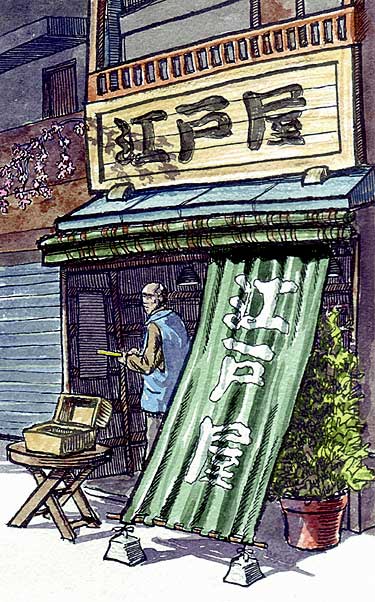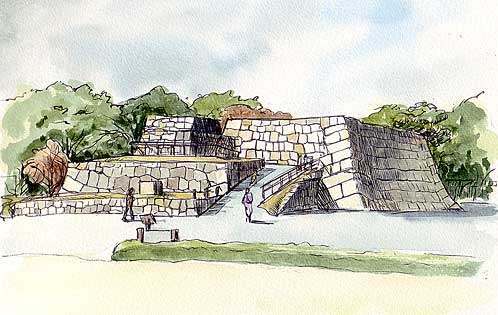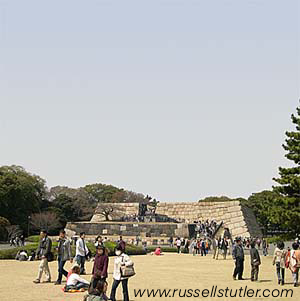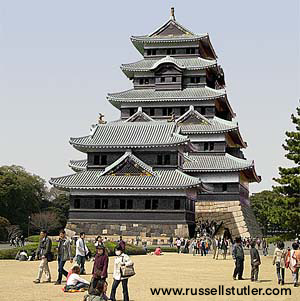|
Page 1 Edo Castle: Japan's forgotten centerpiece After waiting impatiently through the winter for the weather to warm to the point where I could go out sketching, my big break finally came in February. I took my sketch stuff out to the center of Tokyo to the old grounds of Edo Castle. Tokyo used to be a castle town. It's amazing to see such a large expanse of greenery right in the heart of all that steel and concrete. You can see the moats, old stone walls and a few buildings. Right in the center of it all is a huge stone structure that used to be the base of the donjon (tower) of Edo Castle. It's called the "ten shu dai" in Japanese, and Edo Castle is "Edo jo". At the end of the Edo era, the emperor ousted the Tokugawa Shogun and once again became the real ruler of Japan (the emperors had been the leaders in title only during the two and a half century reign of the Shoguns). Emperor Meiji came from Kyoto and took up his residence on the Castle grounds in Edo (Tokyo) in place of the Shogun. Today a large part of the Edo Castle grounds is off limits to the public because the current emperor lives there (and his position is now symbolic rather than political). However, this stone base of the Edo Castle donjon is still open to the public. I drew this with a yatate and waterproof Kaimei mokkan boku sumi ink (see the bottom of page 24 for my observations on this ink). I colored it with watercolor on the spot. A very pleasant day, but it did start to get cold when the sky clouded over. Click on the image to see a larger one. You have to see this thing in person to appreciate how huge it is. The donjon of Edo Castle was the highest in Japan. Just to have some fun, I took a photograph of the stone base and then superimposed a photo of a plastic model of Edo Castle to give you an idea of how big it actually was. You can get an idea of the size from the people who are walking up the ramp on the right part of the stone base. Click on the photos to see larger ones. Should the Edo Castle donjon ever be reconstructed, it would dwarf every other castle in Japan and dominate the skyline in central Tokyo. Imagine how imposing it must have been during the Edo era when there were no skyscrapers to block the view, and you could see it from miles around. However, it was destroyed by fire after being struck by lightning in 1657, only 19 years after it was completed. A few weeks after I uploaded this sketch I read a newspaper article about an organization that is dedicated to reconstruction of the Edo Castle tower. Let's hope they succeed, and that they put a lightning rod on it next time! Here are a few great books on Japaese castles -- which are absolutely fascinating -- plus a link where you can get your own plastic model of Edo Castle and take crazy photos like I did. Japanese Castles 1540-1640 (Fortress) Tokyo neighborhood scenes: old liquor shop A lot of the e-mail I receive regarding this online sketchbook come from people who have been to Japan in the past, who enjoyed seeing familiar scenes here. So I decided to focus more on typical Japanese subjects in my sketches, not necessarily the tourist spots or landmarks, but neighborhood scenes to give you a glimpse of life in Japan. Here is a neighborhood corner liquor store, in the late afternoon as the sun is starting to dip. It sits in anticipation of another evening's activities. This is a very typical combination of old and new with the traditional old Japanese architecture partially obscured by a row of vending machines.  This was quickly drawn with a brush, and the followed up with watercolor. I found this old shop (below) while wandering around the back streets of Asakusa in Tokyo. They invariably have very old shop owners, and very few customers. I don't know how they can survive. Unlike the guy in this sketch, they are often run by women who have outlived their husbands. I was talking with one such woman a few weeks ago who said she would have to shut down her stationery shop and retire soon because there was no heir to take over the business. It was such a nice old shop, I almost wanted to volunteer!  These shops have an irresistable draw for me. The sign says Edo-ya. Edo is the name for old Tokyo during the samurai era (Edo era) and it is still used a lot with pride. People whose families have been in Tokyo for generations are called "Edokko" or children of Edo. Ya means shop, more or less. This was done with brush pen and fountain pen, both filled with carbon ink. It was then finished with Japanese Shin Gansai watercolors in traditional Japanese hues. |
Next page >> |
 |



